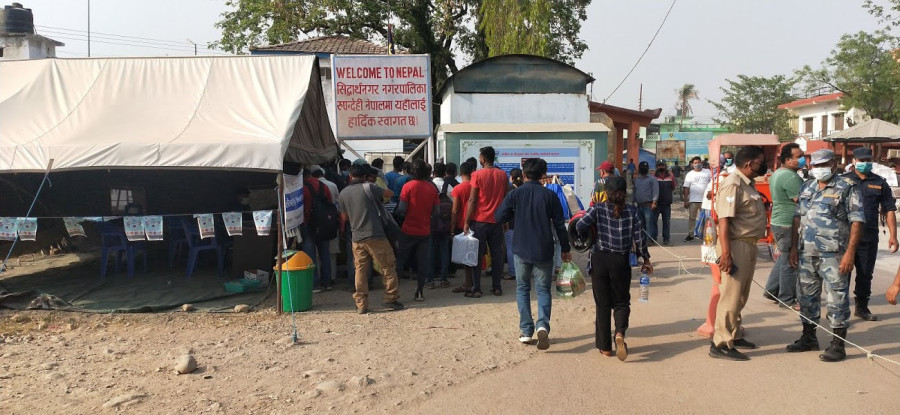Health
Health Ministry to revisit its Covid-19 projection as new cases may exceed 50,000 mark by July
A second wave of infections has already started in Kathmandu Valley but the authorities have still not increased the test numbers, doctors say.
Arjun Poudel
The Ministry of Health and Population says it is working to revisit the projection of new cases of Covid-19 in the next three months.
Earlier, the ministry had estimated that 50,000 additional people would be infected throughout the country between April and July (Chaitra and Ashad according to the Nepali calendar.)
“More people will be infected in the next three months than the projection we made earlier,” Dr Guna Nidhi Sharma, a senior public health administrator at the Health Ministry, told the Post. “We will revisit the estimation and recommend measures to slow down the infection rate.”
The ministry used to make predictions about the number of infected people and officials claimed that most of the projections they made in the past matched in reality.
Public health experts, however, said that the projection of the infected people depends on the number of the tests and if the authorities do not increase the number of tests, resume contact tracing, number of cases may not reach even 50,000.
“Authorities have been performing tests on symptomatic people only,” Dr Anup Subedee, an infectious disease expert, told the Post. “Over two-thirds of the infected people will be missed if we perform tests only on symptomatic people.”
Study shows that over 50 percent of the infected people do not have symptoms.
Tests are also being performed on only symptomatic people returning from abroad including India, where the number of new cases is rising exponentially.
India, which has been severely affected by the second wave of coronavirus, recorded 1,26,789 fresh Covid-19 cases on Thursday, according to media reports.
India’s Uttar Pradesh, which adjoins Nepal, is reported to be in the grip of a second wave of infection, with 6,023 positive cases recorded in the last 24 hours.
According to a media report, 40 doctors including vice-chancellor of King George’s Medical University, have tested positive in the past four days.
The vice-chancellor tested positive for the second time in the last nine months and all the infected doctors had received two doses of vaccine.
Authorities in Nepal have been performing antigen tests at land crossings with India at 16 points for the last few days but only for symptomatic cases.
Doctors say that many people could be asymptomatic and some presymptomatic (infected but in incubation period), who can transmit the virus, without knowing.
“We should keep those arriving from disease-hit areas in mandatory quarantine like in the past,” added Subedee. “New cases have been rising in Kathmandu Valley also but the Health Ministry has not increased the test numbers and resumed contact tracing.”
Authorities have allowed people returning from India or other countries to go home by using public transportation and no agency is regulating their movements.
“If we do not take preventative measures and prepare for the worst case scenario, there is no point in projecting possible case numbers,” Dr Keshav Deuba, a public health epidemiologist, told the Post. “Any projection should be made for preparation and we are lagging far behind in the preparations.”
The Health Ministry has confirmed that the fast spreading variant of coronavirus, the one first detected in the United Kingdom and identified as B.1.1.7, is seen in swab samples of a significant number of new cases.
Scientists in the United Kingdom have said that the UK coronavirus is 40 to 70 percent more transmissible than the one that caused the first wave of infections.
They have also said that the virus variant is 64 percent deadlier than its previous strains.
“Even educated people having Covid-like symptoms are not seeking tests assuming that change in the weather and pollution are responsible for the ailments,” added Deuba.
“There are certain barriers—testing charges, stigma against the infected people, problems of living in rented homes and others, which should be removed to increase testing.”
Doctors say that a second wave of infection has already started in the Kathmandu Valley and what is alarming is that authorities are not increasing the test numbers. They ask agencies concerned to use their own experiences of the past one year.
Nepal so far has reported 279,100 cases of coronavirus infections, with 3,038 deaths.
The Health Ministry said on Wednesday that 332 people were infected in the last 24 hours. Apart from this, 25 people tested positive in antigen examinations performed at the health desks set up on the border with India. The number of active cases stands at 2,454 throughout the country.
“As we are not getting sufficient doses of vaccine to protect our people, the few options we have at present are enforcing safety measures, increasing testing and making contact testing effective,” Dr GD Thakur, former director at the Epidemiology and Disease Control Division, told the Post. “But unfortunately, people in authorised positions are not taking the risk seriously.”
Nepal launched its vaccination drive on January 27 with the Oxford-AstraZeneca vaccine manufactured by the Serum Institute of India under the brand name Covishield.
Nepal so far has vaccinated a little over 1.8 million people. Nepal needs to inoculate 72 percent of its 30 million population against the coronavirus. The World Health Organisation-backed COVAX has committed to providing around 13 million doses of vaccine, enough to inoculate 20 percent of the total population (around 6 million).
However, India’s temporary ban on Covishield could come as an obstacle to the COVAX commitment.
The Health Ministry rolled out the China-gifted vaccine on Wednesday, which will be sufficient to vaccinate around 400,000 people over the next few days.




 16.12°C Kathmandu
16.12°C Kathmandu














